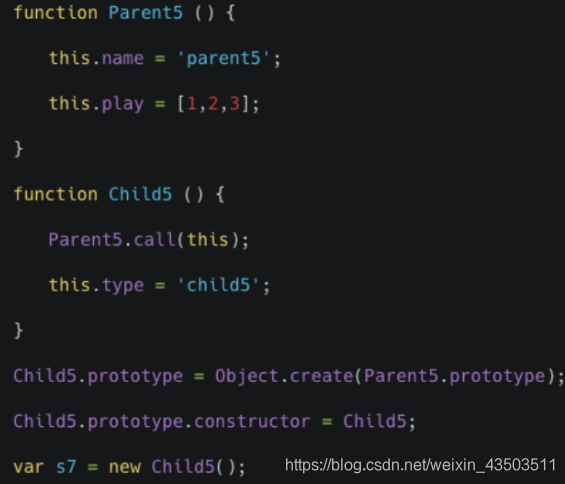1. js繼承的7種方式
回顧:
- 每個構造函數都有一個原型對象;
- 原型對象都包含一個指向構造函數的指針;
- 實例都包含一個指向原型對象的內部指針;
- 一切皆為對象,只要是對象,就會有 proto 屬性,該屬性存儲了指向其構造的指針。
1.1確定原型和實例的關系:
1.1.1instanceOf
使用 instanceof操作符來檢測實例與原型鏈中出現過的構造函數,結果就會返回true;
因此可以說instance是Object、SuperType或SubType中任何一個類型的原型。
1.1.2 isPrototypeOf
只要是原型鏈中出現過的原型,都可以說是該原型鏈派生的實例的原型,因此isPrototypeOf()方法也會返回true。
Object.prototype.isPrototypeOf(instance)
SuperType.prototype.isPrototypeOf(instance)
SubType.prototype.isPrototypeOf(instance)
1.2 7中方式
1.2.1 原型鏈:子類原型對象等于超類的實例
Object.prototype.isPrototypeOf(instance)
SuperType.prototype.isPrototypeOf(instance)
SubType.prototype.isPrototypeOf(instance)
function SuperType() {this.colors = ['red','yellow','blue']
}
function SubType() {
}
SubType.prototype = new SuperType()
var instance1 = new SubType()
instance1.colors.push('green')
var instance2 = new SubType()
instance2.colors // ['red','yellow','blue', 'green']
2個問題(引用類型、不能向超類型的構造函數傳遞參數)
1.2.2 借用構造函數: 在SubType內部SuperType.call(this, 'Lee') (能解決原型鏈的2個問題)
2個問題
- 構造函數模式的通病
每個方法都要在每個實例上重新創建一遍!不同實例上的同名函數是不相等的,然而,創建2個完成同樣任務的Function實例的確沒有必要。
- 超類型的原型中定義的方法,對子類型而言是不可見的
1.2.3 組合繼承
借用構造函數方式,解決傳參和引用 + 原型鏈方式,使用原型鏈上的方法
無論什么情況下,都會調用兩次超類型構造函數:一次是在創建子類型原型的時候,另一次在子類型構造函數內部。 子類型最終會包含超類型對象的全部實例屬性,但我們不得不在調用子類型構造函數時重寫這些屬性。
function SuperType(name) {this.name = namethis.colors = ['red','yellow','blue']
}
SuperType.prototype.sayName = function() {alert(this.name)
}
function SubType(name, age) {SuperType.call(this, name) // 第二次調用超類型構造函數,在新對象上創建了實例屬性name、colors,將屏蔽原型中的兩個同名屬性this.age = age
}
SubType.prototype = new SuperType() //第一次調用超類型構造函數,SubType.prototype 獲得兩個屬性:name、colors
var instance1 = new SubType('Lee', 26)
instance1.colors.push('green')
var instance2 = new SubType()
instance2.colors // ['red','yellow','blue']1.2.4 原型式繼承-和原型鏈對應
在沒有必要興師動眾地創建構造函數,而只是想讓一個對象與另一個對象保持類似的情況下,原型式繼承時完全可以勝任的
相同問題:引用類型值的屬性會共享
從本質上講,object()對傳入其中的對象執行了一次淺拷貝
function object(o) {function F() {}F.prototype = oreturn new F()
}
Object.create()
兩個參數:
- 用來作為新對象原型的對象
- 對新對象定義額外屬性的對象,與
Object.defineProperties()方法的第二個參數格式相同,每個屬性都是通過自己的描述符定義的。
var person = {name: 'Lee',friends: ['a', 'b']
}
var p1 = Object.create(person)
p1.name = 'Yoona'
p1.friends = ['c']
var p2 = Object.create(person)
p2.name = 'Jessica'
p2.friends.push('d')
console.log(person.friends) // a, b, c, d
1.2.5 寄生式繼承-和構造函數對應
只能解決方法復用,沒有解決引用
function createPerson(original) {// var clone = object(original)var clone = Object.create(original)clone.sayHi = function() {alert('Hi')}return clone
}
var p = {name: 'Lee',friends: ['a', 'b']
}
var p1 = createPerson(p)
p1.sayHi()
p1.friends.push('cs')
console.dir(p.friends)// a b cs1.2.6 寄生組合式繼承-解決組合繼承問題
通過借用構造函數:繼承屬性
通過原型鏈的混合形成:繼承方法
目的:不必為了指定子類型的原型而調用超類型的構造函數,可以使用寄生式繼承來繼承超類型的原型。

call借用構造函數繼承屬性和方法Object.create來指定原型- 添加
constructor從而彌補重寫原型而失去的默認的屬性
1.2.7 ES6 Class的繼承 extends關鍵字
子類必須在constructor方法中調用super方法
class Point {constructor(x, y) {this.x = x;this.y = y;}
}class ColorPoint extends Point {constructor(x, y, color) {super(x, y);this.color = color;}
}
let cp = new ColorPoint(25, 8, 'green');cp instanceof ColorPoint // true
cp instanceof Point // true
父類的靜態方法,也會被子類繼承。
class A {static hello() {console.log('hello world');}
}class B extends A {
}B.hello() // hello world
2. js作用域的類型
全局 局部 塊級
3. 塊級作用域和全局、局部作用域的區別
4. 閉包
描述用詞一定要準確
閉包讀取內部嵌套函數的變量
閉包的優點、缺點:
閉包:能夠讀取其他函數內部變量的函數。(應用場景:要獲取某函數內部的局部變量)
閉包的優點:1.能夠讀取函數內部的變量 2.讓這些變量一直存在于內存中,不會在調用結束后,被垃圾回收機制回收
閉包的缺點:正所謂物極必反,由于閉包會使函數中的變量保存在內存中,內存消耗很大,所以不能濫用閉包,解決辦法是,退出函數之前,將不使用的局部變量刪除。
5. vue的api – 讀vue文檔
vue-router是vue的生態

6. computed和watch的區別
一切關于vue的,參考文檔最合理
計算屬性和偵聽器
6.1 計算屬性
- 對于任何復雜邏輯,你都應當使用計算屬性;
- 我們提供的函數將用作計算屬性的 getter 函數;
- 計算屬性緩存vs 方法(計算屬性是基于它們的響應式依賴進行緩存的。只在相關響應式依賴發生改變時它們才會重新求值。這就意味著只要 message 還沒有發生改變,多次訪問 reversedMessage 計算屬性會立即返回之前的計算結果,而不必再次執行函數)每當觸發重新渲染時,調用方法將總會再次執行函數。【假設我們有一個性能開銷比較大的計算屬性 A,它需要遍歷一個巨大的數組并做大量的計算。】;
Date.now()不是響應式依賴;- 計算屬性默認只有 getter,不過在需要時你也可以提供一個 setter;
6.2 偵聽屬性
- 當需要在數據變化時執行異步或開銷較大的操作時,這個方式是最有用的。question-answer,限制我們執行該操作的頻率,并在我們得到最終結果前,設置中間狀態。
- 無緩存性,頁面重新渲染時值不變化也會執行。
7. 對vue的對象進行深度監聽
7.1 deep:true
watch:{obj:{ //監聽的對象deep:true, //深度監聽設置為 truehandler:function(newV,oldV){console.log('watch中:',newV)}}
}
data () {return {obj:{name:'夜空中最亮的星星',age:18}}},watch:{'obj.name':{deep:true,handler:function(newV,oldV){console.log('watch中:',newV)}}}
7.2 計算屬性+偵聽器
data () {return {obj:{name:'夜空中最亮的星星',age:18}}},computed:{name(){return this.obj.name;}},watch:{name(newV){console.log('watch中name為:',newV)}}
8. 節流和防抖
9. vue的生命周期
創建 掛載 更新 銷毀
VUE-生命周期/請求數據
詳解vue生命周期-一篇文章搞懂詳細過程
<!DOCTYPE html>
<html lang="en">
<head><meta charset="UTF-8"><meta name="viewport" content="width=device-width, initial-scale=1.0"><meta http-equiv="X-UA-Compatible" content="ie=edge"><title>Document</title>
</head>
<body><div id="app"><button @click="des">銷毀</button><button @click="add">修改狀態</button>{{ count }}</div>
</body>
<script src="vue.js"></script>
<script>new Vue({el: '#app',data: {count: 0},methods: {add () {this.count += 1},des () {this.$destroy() // 觸發銷毀}},beforeCreate () {console.log('創建實例之前', this.$el) // undefinedconsole.log('創建實例之前', this.$data) // undefinedconsole.log('創建實例之前', this.count) // undefined},created () {console.log('創建實例成功', this.$el) // undefinedconsole.log('創建實例成功', this.$data) // {count: 0}console.log('創建實例成功', this.count) // 0},beforeMount () {console.log('裝載之前', this.$el) // <div id="app"></div>console.log('裝載之前', this.$data) // {count: 0}console.log('裝載之前', this.count) // 0},mounted () {console.log('裝載之后', this.$el) // <div id="app"></div>console.log('裝載之后', this.$data) // {count: 0}console.log('裝載之后', this.count) // 0},beforeUpdate () {console.log('更新之前', this.$el) // <div id="app"></div>console.log('更新之前', this.$data) // {count: 0}console.log('更新之前', this.count) // 1},updated () {console.log('更新之后', this.$el) // <div id="app"></div>console.log('更新之后', this.$data) // {count: 0}console.log('更新之后', this.count) // 1},beforeDestroy () {console.log('銷毀之前', this.$el) // <div id="app"></div>console.log('銷毀之前', this.$data) // {count: 0}console.log('銷毀之前', this.count) // 1},destroyed () {console.log('銷毀之后', this.$el) // <div id="app"></div>console.log('銷毀之后', this.$data) // {count: 0}console.log('銷毀之后', this.count) // 1}})
</script>
</html>
10. 在beforeCreated和created之間能請求數據嗎
無論在哪個生命周期都是能請求數據的,只是不一定能渲染
在生命周期的什么階段進行請求:看需求
一般在 created 里面就可以,如果涉及到需要頁面加載完成之后的操作話就用 mounted;
- created 階段的優勢是:請求時間比較早,頁面 loading 時間相對較短;
- mounted 階段的優勢是:頁面已經渲染完成,如果想請求之后進行 DOM 操作的話,必須在 mounted 階段發起請求;
11. 什么是虛擬DOM
12. 什么是MVVM框架
13. 解釋響應式原理
在源代碼中是怎么實現的
14. 項目中的難點
代表性、成就感最高的——決定了做到什么程度
15. 大數據渲染
16. 循環數組的方式
forEach沒有返回值,返回值undefined?斟酌
17. vue的雙向數據綁定
Vue內部通過Object.defineProperty方法屬性攔截的方式,把data對象里每個數據的讀寫轉化成getter/setter,當數據變化時通知視圖更新。
vue的雙向綁定原理及實現
代碼實現:細讀!!!
- 【數據層】【視圖層】的數據同步
- 數據劫持+發布者-訂閱者模式
Object.defineProperty()方法會直接在一個對象上定義一個新屬性,或者修改一個對象的現有屬性,并返回此對象。
17. 1 對象屬性
ECMAScript中有兩種屬性: 數據屬性和訪問器屬性, 數據屬性一般用于存儲數據數值, 訪問器屬性對應的是set/get操作, 不能直接存儲數據值, 每種屬性下面又都含有四個特性.下面介紹一下:
17.1.1 數據屬性(數值)
1.[[Configurable]]: 表示能否通過delete將屬性刪除,能否把屬性修改為訪問器屬性, 默認為false。當把屬性Configurable設置為false后,該屬性不能通過delete刪除,并且也無法再將該屬性的Configurable設置回true
2.[[Enumerable]]: 表示屬性可否被枚舉(即是否可以通過for in循環返回),默認false
3.[[Writable]]: 表示屬性是否可寫(即是否可以修改屬性的值),默認false
4.[[Value]]: 該屬性的數據值, 默認是undefined
17.1.1 訪問器屬性(set/get操作)
1.[[Configurable]]: 表示能否通過delete將屬性刪除,能否把屬性修改為數據屬性, 默認為false。當把屬性Configurable設置為false后,該屬性不能通過delete刪除,并且也無法再將該屬性的Configurable設置回true
2.[[Enumerable]]: 表示屬性可否被枚舉(即是否可以通過for in循環返回),默認false
3.[[Get]]: 讀取屬性時調用的函數, 默認為undefined
4.[[Set]]: 寫入屬性時調用的函數, 默認是undefined



)










構造方法)



![[js] 處理字符串換行造成的json解析失敗](http://pic.xiahunao.cn/[js] 處理字符串換行造成的json解析失敗)
